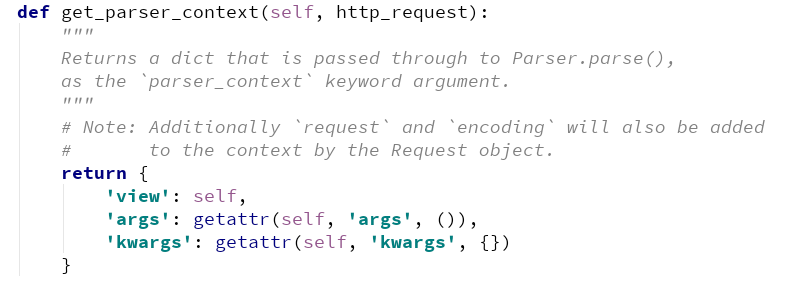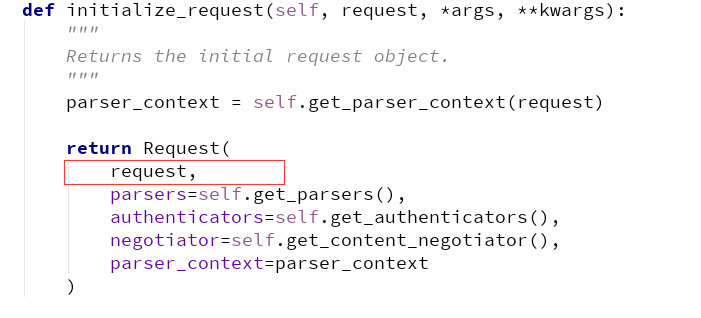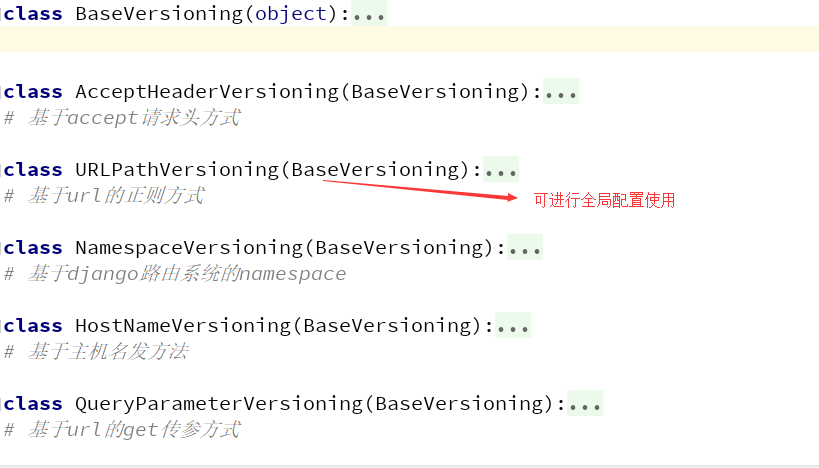1.总体流程分析
rest_framework/view.py
请求通过url分发,触发as_view方法,该方法在ViewSetMixin类下

点进去查看as_view源码说明,可以看到它在正常情况下是zhix执行了self.dispatch(request, *args, **kwargs)方法

@classonlymethod def as_view(cls, actions=None, **initkwargs): """ Because of the way class based views create a closure around the instantiated view, we need to totally reimplement `.as_view`, and slightly modify the view function that is created and returned. """ # The suffix initkwarg is reserved for displaying the viewset type. # eg. 'List' or 'Instance'. cls.suffix = None # The detail initkwarg is reserved for introspecting the viewset type. cls.detail = None # Setting a basename allows a view to reverse its action urls. This # value is provided by the router through the initkwargs. cls.basename = None # actions must not be empty if not actions: raise TypeError("The `actions` argument must be provided when " "calling `.as_view()` on a ViewSet. For example " "`.as_view({'get': 'list'})`") # sanitize keyword arguments for key in initkwargs: if key in cls.http_method_names: raise TypeError("You tried to pass in the %s method name as a " "keyword argument to %s(). Don't do that." % (key, cls.__name__)) if not hasattr(cls, key): raise TypeError("%s() received an invalid keyword %r" % ( cls.__name__, key)) def view(request, *args, **kwargs): self = cls(**initkwargs) # We also store the mapping of request methods to actions, # so that we can later set the action attribute. # eg. `self.action = 'list'` on an incoming GET request. self.action_map = actions # Bind methods to actions # This is the bit that's different to a standard view for method, action in actions.items(): handler = getattr(self, action) setattr(self, method, handler) if hasattr(self, 'get') and not hasattr(self, 'head'): self.head = self.get self.request = request self.args = args self.kwargs = kwargs # And continue as usual return self.dispatch(request, *args, **kwargs) # take name and docstring from class update_wrapper(view, cls, updated=()) # and possible attributes set by decorators # like csrf_exempt from dispatch update_wrapper(view, cls.dispatch, assigned=()) # We need to set these on the view function, so that breadcrumb # generation can pick out these bits of information from a # resolved URL. view.cls = cls view.initkwargs = initkwargs view.suffix = initkwargs.get('suffix', None) view.actions = actions return csrf_exempt(view)
通过查找可以看到dispatch方法在这个class APIView(View)类里
class APIView(View): # The following policies may be set at either globally, or per-view. renderer_classes = api_settings.DEFAULT_RENDERER_CLASSES parser_classes = api_settings.DEFAULT_PARSER_CLASSES authentication_classes = api_settings.DEFAULT_AUTHENTICATION_CLASSES throttle_classes = api_settings.DEFAULT_THROTTLE_CLASSES permission_classes = api_settings.DEFAULT_PERMISSION_CLASSES content_negotiation_class = api_settings.DEFAULT_CONTENT_NEGOTIATION_CLASS metadata_class = api_settings.DEFAULT_METADATA_CLASS versioning_class = api_settings.DEFAULT_VERSIONING_CLASS # Allow dependency injection of other settings to make testing easier. settings = api_settings
从源码介绍我们可以看到,相关的组件,这里做了全局配置

请求到dispatch后,做了封装request和认证两件事,
def dispatch(self, request, *args, **kwargs): """ `.dispatch()` is pretty much the same as Django's regular dispatch, but with extra hooks for startup, finalize, and exception handling. """ self.args = args self.kwargs = kwargs # 对原始request进行加工,封装request request = self.initialize_request(request, *args, **kwargs) self.request = request self.headers = self.default_response_headers # deprecate? try: # 认证 self.initial(request, *args, **kwargs) # Get the appropriate handler method if request.method.lower() in self.http_method_names: handler = getattr(self, request.method.lower(), self.http_method_not_allowed) else: handler = self.http_method_not_allowed response = handler(request, *args, **kwargs) except Exception as exc: response = self.handle_exception(exc) self.response = self.finalize_response(request, response, *args, **kwargs) return self.response
self.initialize_request(request, *args, **kwargs):--->封装request
def initialize_request(self, request, *args, **kwargs): """ Returns the initial request object. """ parser_context = self.get_parser_context(request) return Request( request, parsers=self.get_parsers(), authenticators=self.get_authenticators(), negotiator=self.get_content_negotiator(), parser_context=parser_context )
这里它返回了初始请求对象Request,它继承了Request类
其中的几个方法:



这里要说明的是最终的authentication_classes它到了全局去查找
接下来执行self.initial(request, *args, **kwargs),我们点进去,这是运行之前需要执行的方法
def initial(self, request, *args, **kwargs): """ Runs anything that needs to occur prior to calling the method handler. """ self.format_kwarg = self.get_format_suffix(**kwargs) # Perform content negotiation and store the accepted info on the request neg = self.perform_content_negotiation(request) request.accepted_renderer, request.accepted_media_type = neg # Determine the API version, if versioning is in use. version, scheme = self.determine_version(request, *args, **kwargs) request.version, request.versioning_scheme = version, scheme # Ensure that the incoming request is permitted self.perform_authentication(request) self.check_permissions(request) self.check_throttles(request)
调用方法处理程序之前,依次执行了四个restframework给我们的组件,版本管理,用户认证,权限,节流

这里自上而下执行,版本就没啥说了,先来看用户认证:
def perform_authentication(self, request): """ Perform authentication on the incoming request. Note that if you override this and simply 'pass', then authentication will instead be performed lazily, the first time either `request.user` or `request.auth` is accessed. """ request.user
需要说明的是,这里的request其实是封装之后的request,读者一般第一次看到这里可能会比较纳闷,request.user是啥,其实这里的user调用了property属性


这里的user方法说明,返回与当前请求关联的用户,由提供给请求的身份验证类进行身份验证。
对于这里的self._authenticate():
def _authenticate(self): """ Attempt to authenticate the request using each authentication instance in turn. """ for authenticator in self.authenticators: try: user_auth_tuple = authenticator.authenticate(self) except exceptions.APIException: self._not_authenticated() raise if user_auth_tuple is not None: self._authenticator = authenticator self.user, self.auth = user_auth_tuple return self._not_authenticated()
这里循环我们的authenticator,如果有返回值则执行authenticate(self)方法,最终返回的是个元祖,其中有user,token两个值
如果上面方法执行抛出异常,则执行self._not_authenticated()方法,设置表示未经身份验证的请求的authenticator,user和authtoken。默认为None,AnonymousUser&None。
整个restframework声明周期在这里在说明一下:
发送请求-->Django的wsgi-->中间件-->路由系统_执行CBV的as_view(),就是执行内部的dispath方法-->在执行dispath之前,有版本分析 和 渲染器
在dispath内,对request封装-->版本-->认证-->权限-->限流-->视图-->如果视图用到缓存( request.data or request.query_params )就用到了 解析器-->视图处理数据,用到了序列化(对数据进行序列化或验证) -->视图返回数据可以用到分页
2.用户登录认证
对于rest_framework给我们提供的这个内置认证组件
在authentication.py文件下包含的认证类:

包含了这么多,但我们其实也是基于上面的BaseAuthentication来重写我们的用户认证,先来看看源码:
class BaseAuthentication(object): """ All authentication classes should extend BaseAuthentication. """ def authenticate(self, request): """ Authenticate the request and return a two-tuple of (user, token). """ raise NotImplementedError(".authenticate() must be overridden.") def authenticate_header(self, request): """ Return a string to be used as the value of the `WWW-Authenticate` header in a `401 Unauthenticated` response, or `None` if the authentication scheme should return `403 Permission Denied` responses. """ pass
说了一大堆东西,最终也只是解释性说明,还是需要我们自己来写相关的用户认证,官方只给我们提供了这么一个框架而已
这里相关具体使用方法可以参考我的这篇博客
具体流程:
创建认证类,继承BaseAuthentication,重写authenticate方法和authenticate_header方法
对于authenticate()方法的返回值:
可以返回 raise AuthenticationFailed({'code':1000,'error':'认证失败'}) 需要导入:from rest_framework.exceptions import AuthenticationFailed
可以返回一个元祖 return (token_obj.user, token_obj)
token_obj.user赋值给了request.user
token_obj赋值给了request.auth
这里还要注意它的使用,可以在全局配制,亦可以在局部配制:
对于局部,直接在上面加上authentication_classes = [BaseAuthentication,]
对于全局,需要在我们方setting下进行restframework全局设置
REST_FRAMEWORK = { "DEFAULT_AUTHENTICATION_CLASSES":['API.utils.auth.Authentication',] }
3. 权限认证
permissions.py:
class BasePermission(object): """ A base class from which all permission classes should inherit. """ def has_permission(self, request, view): """ Return `True` if permission is granted, `False` otherwise. """ return True def has_object_permission(self, request, view, obj): """ Return `True` if permission is granted, `False` otherwise. """ return True
这里BasePermission类给我们提供了has_permission方法,和has_has_object_permission两个方法,都是让我们自己重写,最终返回值都是都是布尔值,以此判定是否具有权限
我们需要编写自己的类,来继承BasePermission
使用样式伪代码:
class TestView(APIView): # 认证的动作是由request.user触发 authentication_classes = [TestAuthentication, ] # 权限 # 循环执行所有的权限 permission_classes = [TestPermission, ] def get(self, request, *args, **kwargs): # self.dispatch print(request.user) print(request.auth) return Response('GET请求,响应内容') def post(self, request, *args, **kwargs): return Response('POST请求,响应内容')
以上是在局部配置,全局配置只需在配置文件中写入即可
细节详情参考博客
4.节流
throttling.py:
class BaseThrottle(object): """ Rate throttling of requests. """ def allow_request(self, request, view): """ Return `True` if the request should be allowed, `False` otherwise. """ raise NotImplementedError('.allow_request() must be overridden') def get_ident(self, request): """ Identify the machine making the request by parsing HTTP_X_FORWARDED_FOR if present and number of proxies is > 0. If not use all of HTTP_X_FORWARDED_FOR if it is available, if not use REMOTE_ADDR. """ xff = request.META.get('HTTP_X_FORWARDED_FOR') remote_addr = request.META.get('REMOTE_ADDR') num_proxies = api_settings.NUM_PROXIES if num_proxies is not None: if num_proxies == 0 or xff is None: return remote_addr addrs = xff.split(',') client_addr = addrs[-min(num_proxies, len(addrs))] return client_addr.strip() return ''.join(xff.split()) if xff else remote_addr def wait(self): """ Optionally, return a recommended number of seconds to wait before the next request. """ return None
可以看出这是一个父类,它只提供了返回值,这里具体就是代码的编写了,怎么才能做到时间段内的固定访问次数呢,肯定需要用到时间模块以及该用户的ip了,通过
RECORD = {
'用户IP': [12312139, 12312135, 12312133, ]
}
的形式来做判断
代码演示:
from rest_framework.throttling import BaseThrottle import time D = {} # {'127.0.0.1': [1533302442, 1533302439,...]} class MyThrottle(BaseThrottle): # 点进源码直接看当中携带的参数 def allow_request(self, request, view): """ Return `True` if the request should be allowed, `False` otherwise. """ # 访问当前IP ip = request.META.get('REMOTE_ADDR') print(ip) now = time.time() if ip not in D: D[ip] = [] # 初始化一个空的访问历史列表 history = D[ip] # 当历史列表中有元素,并且当前时间戳减去最后一个元素的时间戳大于10 while history and (now - history[-1]) > 10: history.pop() # 判断最近10秒内的访问次数是否超过了阈值(3次) if len(history) >= 3: return False else: # 把这一次的访问时间加到访问历史列表的第一位 D[ip].insert(0,now) return True
具体操作链接
这里也能使用它内部封装好的子类进行操作
class SimpleRateThrottle(BaseThrottle): """ A simple cache implementation, that only requires `.get_cache_key()` to be overridden. The rate (requests / seconds) is set by a `rate` attribute on the View class. The attribute is a string of the form 'number_of_requests/period'. Period should be one of: ('s', 'sec', 'm', 'min', 'h', 'hour', 'd', 'day') Previous request information used for throttling is stored in the cache. """ cache = default_cache timer = time.time cache_format = 'throttle_%(scope)s_%(ident)s' scope = None THROTTLE_RATES = api_settings.DEFAULT_THROTTLE_RATES def __init__(self): if not getattr(self, 'rate', None): self.rate = self.get_rate() self.num_requests, self.duration = self.parse_rate(self.rate) def get_cache_key(self, request, view): """ Should return a unique cache-key which can be used for throttling. Must be overridden. May return `None` if the request should not be throttled. """ raise NotImplementedError('.get_cache_key() must be overridden') def get_rate(self): """ Determine the string representation of the allowed request rate. """ if not getattr(self, 'scope', None): msg = ("You must set either `.scope` or `.rate` for '%s' throttle" % self.__class__.__name__) raise ImproperlyConfigured(msg) try: return self.THROTTLE_RATES[self.scope] except KeyError: msg = "No default throttle rate set for '%s' scope" % self.scope raise ImproperlyConfigured(msg) def parse_rate(self, rate): """ Given the request rate string, return a two tuple of: <allowed number of requests>, <period of time in seconds> """ if rate is None: return (None, None) num, period = rate.split('/') num_requests = int(num) duration = {'s': 1, 'm': 60, 'h': 3600, 'd': 86400}[period[0]] return (num_requests, duration) def allow_request(self, request, view): """ Implement the check to see if the request should be throttled. On success calls `throttle_success`. On failure calls `throttle_failure`. """ if self.rate is None: return True self.key = self.get_cache_key(request, view) if self.key is None: return True self.history = self.cache.get(self.key, []) self.now = self.timer() # Drop any requests from the history which have now passed the # throttle duration while self.history and self.history[-1] <= self.now - self.duration: self.history.pop() if len(self.history) >= self.num_requests: return self.throttle_failure() return self.throttle_success() def throttle_success(self): """ Inserts the current request's timestamp along with the key into the cache. """ self.history.insert(0, self.now) self.cache.set(self.key, self.history, self.duration) return True def throttle_failure(self): """ Called when a request to the API has failed due to throttling. """ return False def wait(self): """ Returns the recommended next request time in seconds. """ if self.history: remaining_duration = self.duration - (self.now - self.history[-1]) else: remaining_duration = self.duration available_requests = self.num_requests - len(self.history) + 1 if available_requests <= 0: return None return remaining_duration / float(available_requests)
只用它的好处在于省去了大量代码,只要实现逻辑层相关业务即可
自己写的throttle.py:
from rest_framework.throttling import SimpleRateThrottle class VisitThrottle(SimpleRateThrottle): '''匿名用户60s只能访问三次(根据ip)''' scope = 'OP' #这里面的值,自己随便定义,settings里面根据这个值配置Rate def get_cache_key(self, request, view): #通过ip限制节流 return self.get_ident(request) # 远程IP地址 class UserThrottle(SimpleRateThrottle): '''登录用户60s可以访问10次''' scope = 'OA' #这里面的值,自己随便定义,settings里面根据这个值配置Rate def get_cache_key(self, request, view): return request.user.username # 返回用户名
setting.py下的配制
REST_FRAMEWORK = { #节流 "DEFAULT_THROTTLE_CLASSES":['API.utils.throttle.UserThrottle'], #全局配置,登录用户节流限制(10/m) "DEFAULT_THROTTLE_RATES":{ 'OP':'3/m', #没登录用户3/m, 'OA':'10/m', #登录用户10/m, } }
5.版本
这里总共有五个类供我们使用
versioning.py

我们一把常用的就是全局使用,其他的用法详见wusir博客
6.分页
这里抛开基类,提供了三个类供我们去使用,每种都具有同的效果
pagination.py

